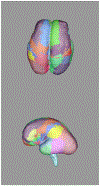Challenges and Opportunities in Connectome Construction and Quantification in the Developing Human Fetal Brain
- PMID: 31592993
- PMCID: PMC6788770
- DOI: 10.1097/RMR.0000000000000212
Challenges and Opportunities in Connectome Construction and Quantification in the Developing Human Fetal Brain
Abstract
The white matter structure of the human brain undergoes critical developmental milestones in utero, which we can observe noninvasively using diffusion-weighted magnetic resonance imaging. In order to understand this fascinating developmental process, we must establish the variability inherent in such a challenging imaging environment and how measurable quantities can be transformed into meaningful connectomes. We review techniques for reconstructing and studying the brain connectome and explore promising opportunities for in utero studies that could lead to more accurate measurement of structural properties and allow for more refined and insightful analyses of the fetal brain. Opportunities for more sophisticated analyses of the properties of the brain and its dynamic changes have emerged in recent years, based on the development of iterative techniques to reconstruct motion-corrupted diffusion-weighted data. Although reconstruction quality is greatly improved, the treatment of fundamental quantities like edge strength requires careful treatment because of the specific challenges of imaging in utero. There are intriguing challenges to overcome, from those in analysis due to both imaging limitations and the significant changes in structural connectivity, to further image processing to address the specific properties of the target anatomy and quantification into a developmental connectome.
Figures






















Similar articles
-
Temporal slice registration and robust diffusion-tensor reconstruction for improved fetal brain structural connectivity analysis.Neuroimage. 2017 Aug 1;156:475-488. doi: 10.1016/j.neuroimage.2017.04.033. Epub 2017 Apr 19. Neuroimage. 2017. PMID: 28433624 Free PMC article.
-
The effects of SIFT on the reproducibility and biological accuracy of the structural connectome.Neuroimage. 2015 Jan 1;104:253-65. doi: 10.1016/j.neuroimage.2014.10.004. Epub 2014 Oct 12. Neuroimage. 2015. PMID: 25312774
-
Edge density imaging: mapping the anatomic embedding of the structural connectome within the white matter of the human brain.Neuroimage. 2015 Apr 1;109:402-17. doi: 10.1016/j.neuroimage.2015.01.007. Epub 2015 Jan 12. Neuroimage. 2015. PMID: 25592996 Free PMC article.
-
Automated processing pipeline for neonatal diffusion MRI in the developing Human Connectome Project.Neuroimage. 2019 Jan 15;185:750-763. doi: 10.1016/j.neuroimage.2018.05.064. Epub 2018 May 28. Neuroimage. 2019. PMID: 29852283 Free PMC article. Review.
-
Potential and limitations of diffusion MRI tractography for the study of language.Brain Lang. 2014 Apr;131:65-73. doi: 10.1016/j.bandl.2013.06.007. Epub 2013 Jul 30. Brain Lang. 2014. PMID: 23910928 Review.
Cited by
-
HAITCH: A Framework for Distortion and Motion Correction in Fetal Multi-Shell Diffusion-Weighted MRI.ArXiv [Preprint]. 2024 Jun 28:arXiv:2406.20042v1. ArXiv. 2024. Update in: Imaging Neurosci (Camb). 2025 Feb 26;3:imag_a_00490. doi: 10.1162/imag_a_00490. PMID: 38979484 Free PMC article. Updated. Preprint.
-
Automatic, Age Consistent Reconstruction of the Corpus Callosum Guided by Coherency From In Utero Diffusion-Weighted MRI.IEEE Trans Med Imaging. 2020 Mar;39(3):601-610. doi: 10.1109/TMI.2019.2932681. Epub 2019 Aug 2. IEEE Trans Med Imaging. 2020. PMID: 31395540 Free PMC article.
-
HAITCH: A framework for distortion and motion correction in fetal multi-shell diffusion-weighted MRI.Imaging Neurosci (Camb). 2025 Feb 26;3:imag_a_00490. doi: 10.1162/imag_a_00490. eCollection 2025. Imaging Neurosci (Camb). 2025. PMID: 40800816 Free PMC article.
References
-
- Jakab A, Kasprian G, Schwartz E, Gruber GM, Mitter C, Prayer D, Schöpf V, and Langs G Disrupted developmental organization of the structural connectome in fetuses with corpus callosum agenesis. Neuroimage, 111:277–288, 2015. - PubMed
-
- Dubois J, Dehaene-Lambertz G, Kulikova S, Poupon C, Hüppi PS, and Hertz-Pannier L. The early development of brain white matter: a review of imaging studies in fetuses, newborns and infants. Neuroscience, 276:48–71, 2014. - PubMed
-
- Pfefferbaum A, Adalsteinsson E, and Sullivan EV. Replicability of diffusion tensor imaging measurements of fractional anisotropy and trace in brain. Journal of Magnetic Resonance Imaging: An Official Journal of the International Society for Magnetic Resonance in Medicine, 18(4):427–433, 2003. - PubMed
Publication types
MeSH terms
Grants and funding
LinkOut - more resources
Full Text Sources

